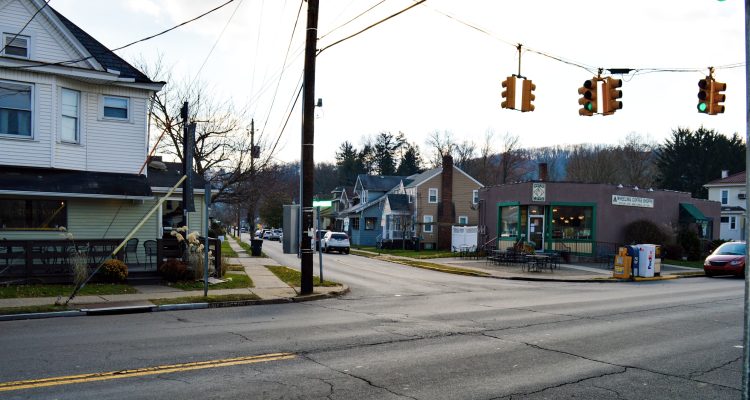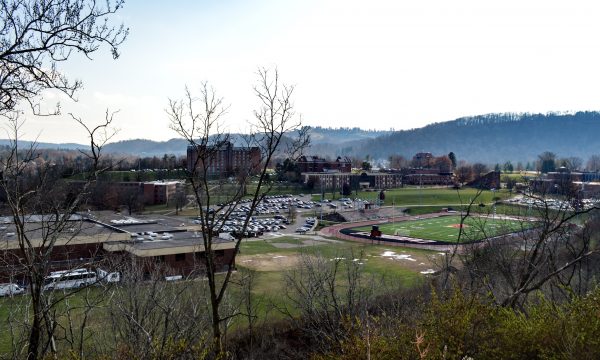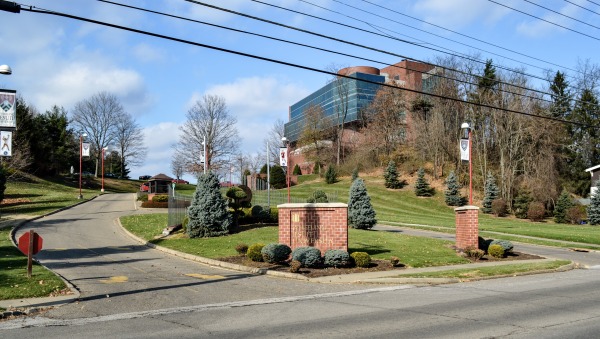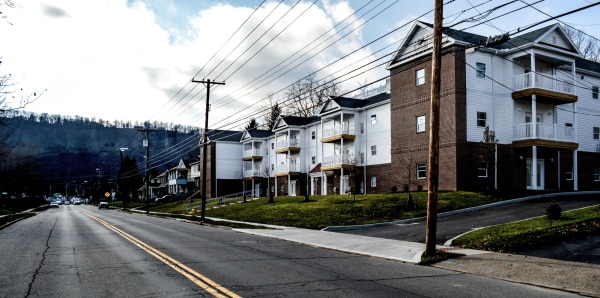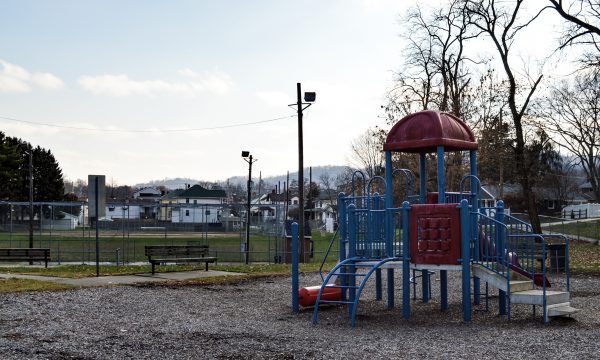By Sharon Goudy
Weelunk.com Contributor
Based around the small, idyllic, fictional town of Mayberry, “The Andy Griffith Show” debuted in the 1960s and remains beloved by many, with today’s TV Land showing its reruns.
Everyone in Mayberry knew his or her neighbors, and residents could walk from their homes to most any place they needed to go. Children played outside and rode their bicycles in the street. It was an easier time, and every episode had a happy ending.
Wheeling has its own modern twists on Mayberry in quite a few of its neighborhoods, and the Pleasanton area is no exception.
Situated from the Mt. De Chantal exit off Interstate 70 to where National Road intersects with Washington Avenue, Pleasanton is a mix of residential properties and business interests. Children still play and ride their bicycles in the streets. During warmer months, they fish and kayak or splash around in Big Wheeling Creek, which abuts the residential A-B-C streets (so named because they intersect with Valley View Avenue in alphabetical order) and the shopping plaza. Much like the fictional Mayberry, Pleasanton residents enjoy a walking lifestyle that is both convenient and coveted by many folks in bigger cities all across America.
The main thoroughfare of Pleasanton is Washington Avenue, which is home to residents as well as several goods and service providers. If they choose, Pleasanton residents are within walking distance to churches; schools; restaurants; a coffee shop; hair salons; small stores for groceries, deli, toiletries, and other household items; a sporting goods store; insurance agents; a mail center; a martial arts facility; a dentist; a law office; a home for the aged; a math and reading center for children; a bank; a gas station; a photography store; and a candy/gift store.
Rounding out these amenities are easy access to the city’s miles of walking trails, a playground, and a ball field, which sees plenty of local action in addition to the wildly popular Edgar Martins Beast of the East baseball tournament each summer.
What sets Pleasanton apart from similar, family-friendly and walkable neighborhoods in Wheeling is the nationally-ranked Wheeling Jesuit University at its heart.
Established as Wheeling College in the mid-1950s by the Diocese of Wheeling-Charleston and the Society of Jesus of the Maryland Province, the institution transitioned to university status about 40 years later. Over the years, Wheeling Jesuit University has grown its academic offerings as well as its physical presence with the expansion of several programs and the addition or improvement of several buildings to the 65-acre campus.
“Although Wheeling is far from considered a college town, WJU has been the anchor of the neighborhood for many years,” said David Miller, council member for the Fourth Ward, which encompasses Pleasanton. “WJU is a small university but has a significant impact on the housing and retail climate of the area.”
Established as Wheeling College in the mid-1950s by the Diocese of Wheeling-Charleston and the Society of Jesus of the Maryland Province, the institution transitioned to university status about 40 years later, according to its web site. Over the years, WJU has grown its academic offerings as well as its physical presence with the expansion of several programs and the addition or improvement of several buildings to the 65-acre campus.
The university also has overseen several federal programs throughout the years and today remains a host for the Challenger Learning Center and the NASA Classroom of the Future. About 1,500 students from 26 states and 20 countries are enrolled at WJU, and the university offers close to 40 programs of study, according its web site.
“Challenges do exist when you have young adults and senior citizens occupying the same neighborhood, but Pleasanton seems to thrive, given the mix of residents,” Miller said.
A controversial addition to the neighborhood over the past year has involved construction of a 36-unit graduate housing facility on Washington Avenue. Upper Washington Avenue was rezoned to accommodate the building, and residents were divided over the project.
“This is the largest and most recent construction project in the area in many years,” Miller said. “Its true impact on the area will be measured in the years to come.”
WJU also owns the former Steenrod School on Steenrod Avenue in the neighborhood as well as other properties along Washington Avenue and even has expanded its doctoral Physical Therapy program to the Stone Center in downtown Wheeling.
Another issue close to people’s hearts in the neighborhood involved the demolition about three years ago of the Mt. De Chantal Visitation Academy, a private school for girls. The school called the neighborhood home from 1848 until 2008 and was overseen by the Sisters of the Visitation.
Because of low enrollment and escalating costs, the school was closed in 2007 and the Sisters relocated to Washington, DC. Area residents and former students made a push to save the property, which was listed on the National Register of Historic Places, from demolition, but their efforts were unsuccessful. The property has been cleared and now is owned by nearby Wheeling Hospital. Plans for the site have yet to be announced.
Unlike the fictional Mayberry, not all episodes in Pleasanton end happily.
Pleasanton was one of the hardest hit neighborhoods by the 100-year flood that happened in September of 2004. Several home owners left their properties after Wheeling Creek massively overflowed its banks, and the number of rental properties has significantly increased on the A-B-C streets over the ensuing decade.
Because of the Biggert-Waters Flood Insurance Reform Act of 2012, residents in Pleasanton and other Wheeling neighborhoods located in flood plains are facing skyrocketing flood insurance premiums, and properties are not moving for sale as quickly as they once did. Residents here and around the country have been pushing for a more permanent, affordable alternative to Biggert-Waters, but so far no consensus has been reached.
Flooding that occurs in Wheeling and fills up basements is far different than flooding that occurs on the country’s coasts and usually is accompanied by hurricanes and total destruction of multi-million dollar vacation properties.
Convenience sometimes makes the neighborhood an easy target for mischief and vandalism, and finding a parking space on the A-B-C streets can be a challenge at times. A recent stabbing at the gas station at the intersection of Washington Avenue, National Road, and Bae Mar was a shock for residents.
Despite these issues, for the most part, residents continue to enjoy a very decent quality of life in Pleasanton, hence the affectionate references and comparisons to Mayberry. On any given day, they might hang out at the coffee shop or the restaurants. WJU’s track and field teams, as well as many other locals, jog or walk along the streets. Professors and students walk to class.
Moms and Dads push their babies and toddlers in strollers to the playground next to the ball field, where other local children practice and play football and baseball. Older residents enjoy front-porch sitting when the weather is warm, and those whose homes rest on the creek bank often find deer grazing in their yards.
“I think Pleasanton is one of Wheeling’s most unique neighborhoods. What’s most unique, in my opinion, is the eclectic mix of residential, commercial, educational, and recreational components,” Miller said. “As a former Pike Cub little-leaguer, I still have fond memories of riding my bike from Woodsdale across the pedestrian bridge on Haddale Avenue to baseball practice.
“Over the years, the commercial activity has evolved, but currently we have several eateries and retail establishments,” he said. “The Washington Avenue shopping area is still a very popular destination whether youngsters are just looking to grab a latte or need a new set of golf clubs.”


